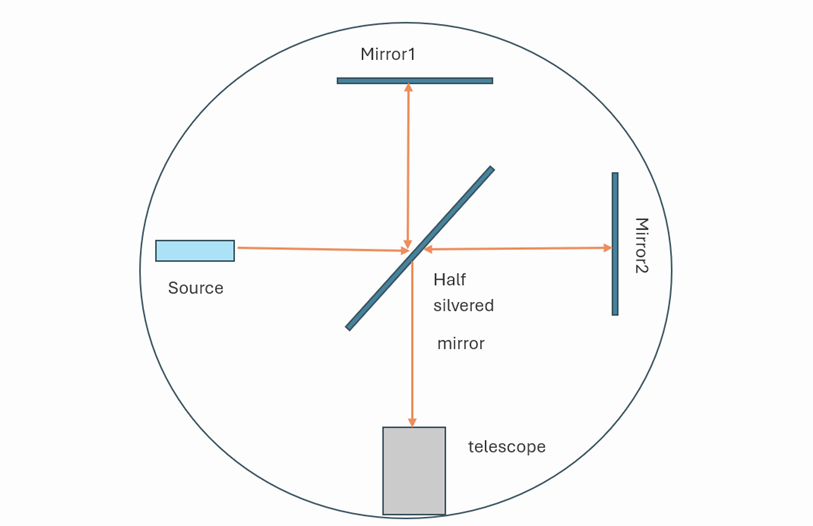The greatest “failed experiment”: A short review of the Michelson-Morley Experiment
- Sevi Digeni
- Aug 23
- 4 min read
Updated: Sep 2
By Sevi Digeni, Year 13 Student
Introduction
One of the most well-known and influential experiments in the history of physics, the Michelson–Morley experiment combines theory from special relativity and wave behaviour. Its result was initially characterised as null, with the two scientists unable to derive a value for what they were looking for. Today, it is widely regarded as the most important "failed" experiment, as it provided key evidence suggesting that in all reference frames, light moves with a speed of constant value, independent of the source/observer [1].
Background
During the 19th century, the consensus in the scientific community was that all transverse waves travelled through a solid medium. As such, numerous experiments were carried out to explore and confirm the presence of a specific medium for light. An example of a hypothesis of this medium is luminiferous aether. Luminiferous aether was speculated to have been invisible, stationary in space as well as large enough to fill all of space, low in density and highly elastic. Its property of elasticity is basically its ability to harden, acting as a solid when fast movements are taking place (e.g. light, fast oscillations) while acting like a fluid to slow movements, similar to oobleck. It was theorised that due to the Earth’s motion through the medium, aether could appear to move in the opposing direction relative to an observer on Earth. The concept is similar to exposing one’s hand against the wind outside a moving car. Scientists hypothesised that the Earth’s movement through the hypothetical medium would result in an "aether wind", which could impact the speed of light [2].
Methods
Michelson and Morey’s goal was to measure Earth’s velocity through aether by identifying the “aether wind” using Newtonian mechanics, which were deemed at the time to be universally correct. They thus built a device called an interferometer to compare the speed of light from dual directions.
The interferometer consisted of a rather simple structure, which is illustrated in Figure 1. A light source and a collimator were used produce a narrow beam of phase-aligned coherent light. The interferometer also contained multiple mirrors, including a half-silvered mirror which divided the main light beam into two distinct beams by allowing only one half of the beam to pass and reflecting the other half. Furthermore, to identify the interference effect produced by the superposition of the two beams, a telescope was used. Finally, researchers included a sandstone slack to minimise quakes, as well as a mercury container to enhance the rotational ability of the slack.

The monochromatic light source projected a light ray towards the half-silvered mirror which then split it into two rays, perpendicular to one another. One ray travelled towards the one mirror (say North) while the other beam travelled towards the other mirror (say East). After striking the mirrors, the beams were reflected and rejoined at the half-silvered mirror. This setup is intended to produce an interference pattern due to the phase difference in separate light beams (due to the different routes taken by each beam, and therefore the difference in time taken to reach a particular point). The hypothesis was that the observed difference in time would be caused by aether, which would alter the speed of one or both of the light rays [3].
Results
The researchers observed that even though they rotated the interferometer to test different directions, nothing changed. Multiple trials were conducted by Michelson and Morley, throughout various times during the day and across the year. Nevertheless, the interference pattern remained unchanged, thus giving a null result.
Discussion
The experiment’s null result highlighted the weaknesses in the theory of luminiferous aether [2]. The experiment also casted doubt on the very existence of the aether itself, while proponents of the model were prompted to propose alternative models to justify the unexpected outcome.
When Einstein developed his special relativity theory, he was able to explain the outcomes of experiments such as the Michelson-Morley experiment without the need for ad hoc assumptions. The results of that experiment thus backed the theory of special relativity, enabling its acceptance and bolstering the rejection of the aether theory [4].
Evidently, the Michelson-Morley experiment was a stepping stone for Einstein and advanced our understanding of the universe and the nature of light.
Yet perhaps even more importantly, there is existing proof that even without clear results, experiments are not invaluable but rather learning points towards deeper understanding.
Bibliography
All figures are produced by the author.
[1] Wells, Sarah. “The Most Famous Failed Experiment.” Smithsonian Science Education Center, 21 Jul. 2016, https://ssec.si.edu/stemvisions-blog/most-famous-failed-experiment.
[2] “Special Relativity: Michelson-Morley Experiment – HSC Physics.” Science Ready, Science Ready, https://scienceready.com.au/pages/michelson-morley-experiment-spectra-of-binary-stars.
[3] Michelson, A. A., and E. W. Morley. “On the Relative Motion of the Earth and the Luminiferous Ether.” American Journal of Science, vol. s3-34, no. 203, Nov. 1887, pp. 333–45. ajsonline.org, https://doi.org/10.2475/ajs.s3-34.203.333.
[4] Editors of Encyclopaedia Britannica. “Michelson-Morley Experiment | Description, Results, & Facts | Britannica.” Britannica, 1 Apr. 2025, https://www.britannica.com/science/Michelson-Morley-experiment.




Comments